The Project Gutenberg EBook of Mound State Monument, Moundville, Alabama, by Alabama Museum of Natural History This eBook is for the use of anyone anywhere in the United States and most other parts of the world at no cost and with almost no restrictions whatsoever. You may copy it, give it away or re-use it under the terms of the Project Gutenberg License included with this eBook or online at www.gutenberg.org. If you are not located in the United States, you'll have to check the laws of the country where you are located before using this ebook. Title: Mound State Monument, Moundville, Alabama Author: Alabama Museum of Natural History Release Date: April 4, 2019 [EBook #59208] Language: English Character set encoding: UTF-8 *** START OF THIS PROJECT GUTENBERG EBOOK MOUND STATE MONUMENT, MOUNDVILLE, ALABAMA *** Produced by Stephen Hutcheson and the Online Distributed Proofreading Team at http://www.pgdp.net
Museum Paper 20 (Revised)

| 1200-1400[1] | Great prehistoric city grows and thrives on banks of Warrior River, West-Central Alabama. |
| 1500[1] | City deserted. |
| 1897 | Town of Carthage, white settlement at site of deserted city, renamed Moundville because of numerous Indian mounds within its limits. |
| 1905-1906 | First archaeological excavations made at Moundville by Clarence B. Moore of the Philadelphia Academy of Natural Sciences. |
| 1923 | Moundville Historical Society organized to arouse interest in preservation of mounds. Mrs. Jeff Powers, Jr., President. |
| 1929 | Alabama Museum of Natural History begins archaeological investigations at Moundville after purchasing 175 acres which include most of the 40 mounds in that area. |
| 1933 | Mound State Park established with the aid of the Federal Emergency Conservation Work Agency. |
| 1935 | Temporary museum building constructed at Mound State Park. |
| 1938-39 | Alabama Museum purchases additional land, enlarging Mound State Park to 301 acres which includes all the mounds in the area. |
| 1938 | Mound State Park renamed Mound State Monument. Civilian Conservation Corps, directed by National Park Service and the Alabama Museum of Natural History, begins large-scale development of area. |
| 1939 | May 10, New Archaeological Museum dedicated. |
| 1947 | September 24, Dedication of Laboratory Unit of Erskine Ramsay Archaeological Research Center. |
| 1949 | Completion of Picnic Building: Memorial to Nelson Jones. |
• OPEN ALL YEAR •
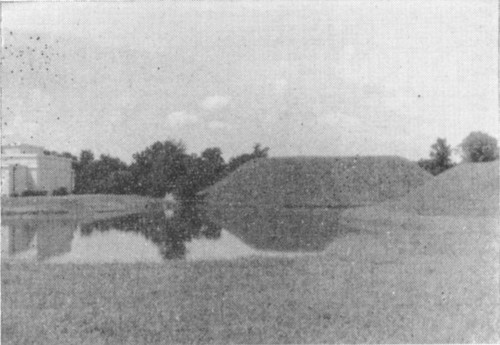
A blisful lyf, a paisible and a swete, Ledden the peples in the former age —Chaucer, Former Age, line 2
The Black Warrior River winds slowly among the rolling southern foothills. On the banks of this river many centuries ago there flourished a great Indian metropolis. Here dwelt a pleasant and contented people whose story is not of warring braves but of peaceful artisans. Theirs were days not of strife and treachery, but of quiet toil and worship. These people, given to pottery-making and the building of fine temples, have vanished long ago. The eloquence of their handiwork endures. Their pottery, lodged in the muddy earth, emerges as fresh proof that “a thing of beauty is a joy forever”. Their temples, decayed these many years, are yet in evidence, for the pyramidal substructures of these temples—earth mounds of imposing size and number—remain.
The mounds and the story of the people who built them, a story recorded in clay and stone and native metal, are preserved today at Mound State Monument.
The Indians dwelling in the ancient city, though of medium stature, were well built and muscular. Their faces were finely molded and handsome.
Considered stylish were “flattened heads”. Head-flattening was caused by strapping the young Indian to a wooden cradle board. The pressure of the leather thongs on the soft bones of the baby’s head caused a flattening which remained throughout life. Such a head seems to have become a mark of good rearing, and greatly to be desired, for many mothers went so far as to strap sand bags on their children’s heads to induce this flattening.

A Moundville Indian skull that was not flattened.
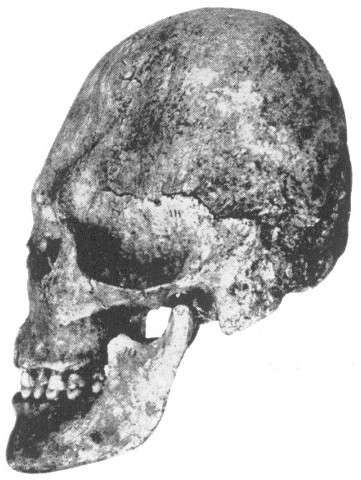
This Moundville Indian skull shows the result of artificial head-flattening.
Leather and fabrics woven of vegetable fibres were fashioned into garments. In extremely cold weather robes made of feathers may have been worn over the rest of their clothing.
The Moundville Indians, both men and women, were fond of personal adornment. They wore ear plugs, bracelets and arm bands of copper, and beads and pendants of bone, stone, shell and copper. Many of their pendants, carved with intricate and delicate designs, would invoke the envy of women of today. Long hairpins were made of bone, and considerable time was devoted to hairdressing.
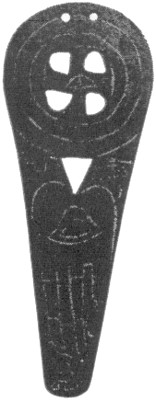
A STONE PENDANT ONCE WORN BY A MOUNDVILLE INDIAN.
From virgin forests the Moundville Indians gathered logs and poles to construct frameworks for their homes. Of reeds and canes gathered along the river they wove house walls, 5 plastering them with thick coatings of moistened sand and clay. Thatched roofs were made of heavy swamp grass. A hole was left in the center to serve as a chimney. The floors were of hard-packed clay frequently covered with sand. These structures were neat, comfortable and weatherproof.
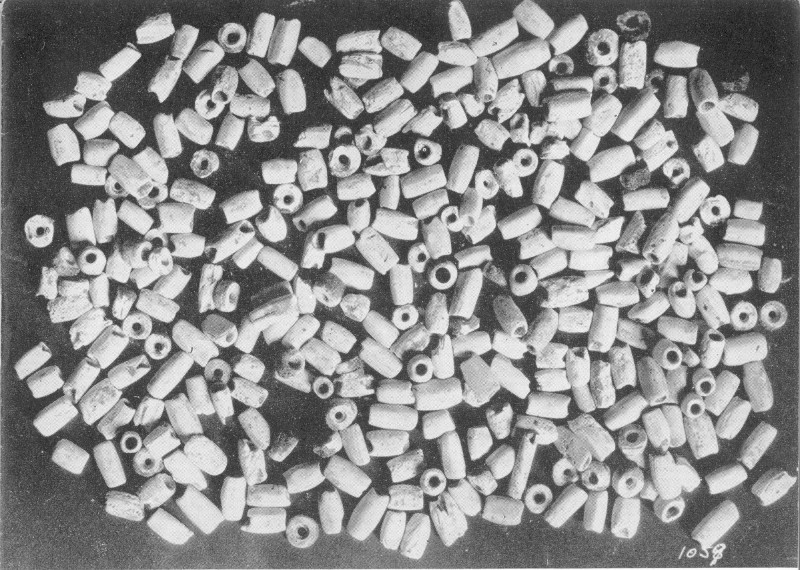
SHELL BEADS WHICH ONCE ADORNED A MOUNDVILLE INDIAN.
Living in a temperate climate amid forests teeming with wild game and streams abundant with fish, the Moundville Indians had little difficulty, experienced few uncertainties, in obtaining their food. In addition to meat and fish obtained from forest and stream there were vegetables from fertile fields which produced with little man-made effort an ample supply of maize, squash, beans and pumpkins.
A community of skilled artisans, these people fashioned many tools for food-getting, shelter-making and 6 clothing-manufacture as well as for more aesthetic pursuits. With nets woven of vegetable fibre and barbless fishhooks of bone and copper they took fish from nearby streams and lakes. With small, skillfully chipped arrowheads they brought down fowl. Ingenious traps ensnared large game. Stone fleshers were used for stripping the meat and dressing the leather. With bone awls and needles sharpened on grinding stones they sewed leather garments. Stone mortars and pestles pulverized their grain. Stone chisels and axes felled, with the aid of fire, trees for their homes and temples. Cups and forks and spoons carved from shell were their cooking and eating utensils.

A MOUNDVILLE INDIAN’S SHELL CUP.

COPPER FISHHOOK USED AT MOUNDVILLE IN PREHISTORIC TIMES.
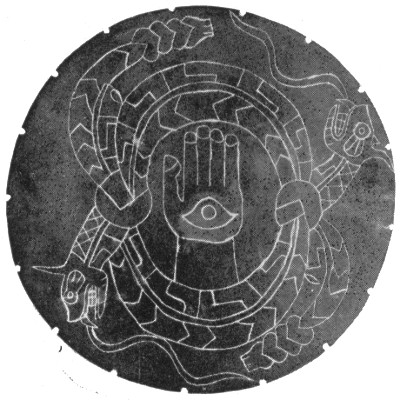
A MEMENTO OF ABORIGINAL RELIGIOUS CEREMONIES AT MOUNDVILLE.
Of paramount importance to the Moundville Indian was his religion. The mounds, on which he worshiped, are enduring monuments to the strength and fervor of his faith. Tons and tons of clay, loam and sand he carried to form these towering structures. Atop the earth pyramids he built great wooden temples and special dwelling houses for chieftans and priests.
Ceremonies performed in the temples were elaborate and colorful. Priests attired in symbolic costumes, and bearing numerous esoteric accoutrements, directed the rituals. Ceremonial trappings included beautiful copper breast plates, shell gorgets, and stone discs and pendants, all delicately carved with intricate, allegorical designs. Among these designs were depictions of the skull and arm-bone, the hand and all-seeing eye, entwined rattlesnakes, and the horned or plumed serpent. Similar designs are found in the symbolic art of the Indians of Central America and Mexico, the Mayas and Aztecs.

PIPES WHICH THE MOUNDVILLE INDIANS MOLDED FROM CLAY.
Games and contests were popular among the Moundville Indians. One favorite game had the combined features of our football and baseball. Another was similar to a combination of bowling and shuffleboard.
Tobacco-smoking was practiced not as a habit but as a ceremony. Beautiful pipes—some carved from stone, others molded from clay—were smoked through a long cane stem, the bowl resting on the ground. Some pipes were shaped to resemble the human body. Others were carved or molded in the shape of birds, animals and insects.
The dead were buried with care and respect. Belief in immortality was expressed by placing material goods near the deceased to sustain him in the other world. His treasured belongings, usually pottery vessels, beads, bracelets and other ornaments, were buried with him.
The Moundville Indian built no burial mounds. His dead were buried in cemetery areas within the city. Usually burial was made in a pit large enough to accommodate the body at full length. Sometimes, however, burial was made in a small pit, the body being drawn up in a flexed position. Burial of the skeleton after it had been stripped of flesh was sometimes practiced.
The very nature of the Moundville Indian’s surroundings provided security and leisure. His time was not consumed in constant search for food and warmth, and to squander his time, grow fat and lazy, was not in him. His skill and versatility required expression, which he found in the art of pottery-making.
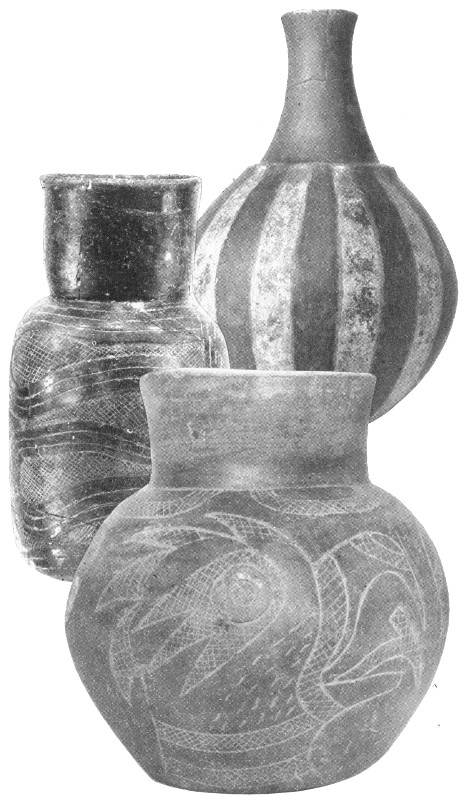
THE MOUNDVILLE POTTER WAS A SKILLED CRAFTSMAN.

VARIETY OF FORM CHARACTERIZES MOUNDVILLE POTTERY.
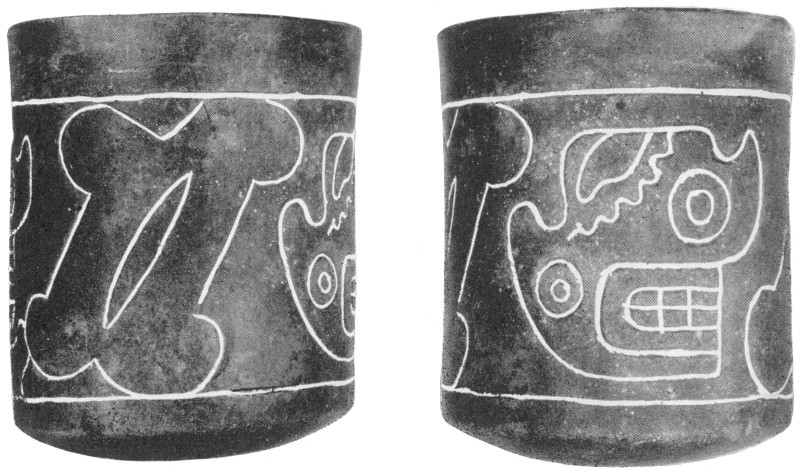
POTTERY BEAKER WITH A SYMBOLIC DESIGN.
After the beaker was removed from the ground by the archaeologist the incised lines were filled with white paint in order to emphasize the design.
He manufactured great quantities of pottery for domestic use. Moistening clay which he took from the river bank, he kneaded into it particles of crushed shell. This was to keep the molded clay from cracking when it hardened. He shaped the clay into jars, pots, bowls and other utilitarian objects, hardening them with fire. This domestic ware was plain, bearing no decoration.
It was through non-utilitarian ware, exquisitely decorated, that the Moundville Indian wrought careful and lasting expression of his artistry. The potter used only his finest clay for this ware. After forming the clay into some delicately molded vessel, then hardening it with fire, he dipped the vessel into a black “wash” which coated it with a smooth, black film. The coloring agent contained in this “wash” was derived, indirectly, from plants.
Usually the potter decorated the vessel with some intricate design, often incising the lines on the vessel before it was hardened, at other times scratching them on the hardened vessel. Sometimes the etched or incised lines of the design were 12 filled with red paint, derived from iron ore, which gave the design a striking appearance on the polished black surface of the vessel.
Water bottles, bowls, pots, shallow dishes, and effigy vessels were made of this thin, black ware. Their forms included frog, duck, beaver, rabbit, eagle, bat, owl, fish, shell and even human shapes.
Designs incised or engraved on this ware depicted the plumed or horned serpent, the ivory-billed woodpecker, eagle, sun, human hand and eye, skull and armbones, and numerous others.
Sometimes vessels were decorated with red and white paint (derived from iron and lead ore) instead of being “washed” black. This type of decoration was not common, however.
The present-day visitor to Mound State Monument may see, on the 300-acre Monument tract, 40 mounds which are the remnants of the Moundville Indians’ great city.
The visitor will be interested in identifying these mounds as domiciliary (as distinguished from burial mounds and effigy mounds found at other Indian sites). These domiciliary mounds, which were erected as substructures for temples and other important buildings, are rectangular truncated-pyramids. Their sizes vary. The largest, called Mound “B” (see map), is 58½ feet high and covers almost two acres.
The several lakes within the Monument area are restorations, made after considerable research, of prehistoric reservoirs. The forty- to sixty-foot bluff at the ancient city’s river front made the Warrior River an impractical source of water supply. These lakes, therefore, may have been used to catch and hold water for daily use and for fishing.
Already constructed through the generosity of Dr. Erskine Ramsay, Birmingham, Alabama, Honorary Chairman of the Board of Regents of the Museum, is a large and spacious laboratory building, in which all archaeological material comprising the Museum’s vast collection is suitably and adequately housed. Space is available for students to study any phase of the subject in which they may be interested. (See photograph on page 20.)
Also completed in the Research Center is one cottage in which a married student might be housed during the period of his studies.
Yet to be constructed are two cottages, a dormitory for unmarried students, and a house for the resident archaeologist.

MOUND “B” AND VISITORS.
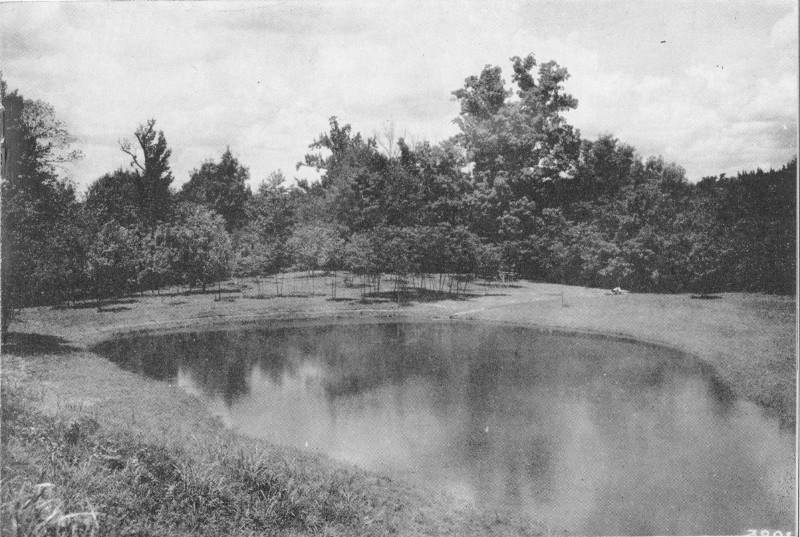
RESTORED PREHISTORIC LAKE AT MOUND STATE MONUMENT.
The archaeological museum houses an exhibit hall and two in situ burial groups. The exhibit hall makes up the main part of the building. The in situ burial groups are enclosed in wings at the north and south ends of the exhibit hall.
Design of the building itself was based on ideas used by the Moundville Indian in shaping and decorating his artifacts. The classic three-step motif expressed in the three roof levels of the museum, and used over the doorway, was a favorite design element of the Moundville artist. The skull and arm-bone design making up the parapet frieze was copied from a design on a Moundville Indian pot (see photograph on p. 11). The medallion over the entrance is an enlarged reproduction of a stone pendant once owned by a Moundville Indian (see photograph on p. 4). This pendant as well as the pot from which the frieze was copied may be seen in the exhibit hall.
Displays in the exhibit hall are designed to illustrate (1) a brief history of prehistoric man, (2) cultural traits and physical characteristics of the prehistoric Moundvillian, and (3) physical features of Mound State Monument.
A brief story of prehistoric mankind is given in the three wall cases to the visitor’s left as he enters the museum. Cultural traits of the Moundville Indian are illustrated in the eight cases along the back wall, and in the five table cases in the exhibit hall. Physical features of Mound State Monument are depicted in the three wall cases to the visitor’s left as he leaves the museum.
The north wing of the museum (to the Visitor’s left as he enters the building) encloses seventeen in situ burials. The south wing (to the visitor’s left as he leaves the building) encloses forty such burials. These fifty-seven burials, together with their accompanying pottery, ornaments and other artifacts, have been uncovered and left in the ground exactly as they were found.
These burials had been placed in a cemetery area, not a mound. Most of the burials were approximately one and one-half feet under the surface of the ground, although some were only four inches underground and others were three feet. The original ground-level is demonstrated in the exhibit by lines drawn around the edges of the pits.
Studies of Moundville skeletal remains have revealed the sex and individual age (i.e., how old the individual was at the time of burial) of each burial, as well as certain physical defects. Effects of head-flattening, a practice described elsewhere on these pages, are apparent on many of the skulls.

IN SITU BURIALS IN NORTH WING OF MUSEUM.

IN SITU BURIALS IN SOUTH WING OF MUSEUM.
BURIALS HAVE BEEN UNCOVERED AND LEFT IN THE GROUND JUST AS THEY WERE FOUND.
Mound State Monument is located on Alabama Highway No. 13 (paved) at the edge of the town of Moundville, Alabama, seventeen miles south of Tuscaloosa, Alabama. The dividing line of Tuscaloosa and Hale Counties runs through the Monument area.
Moundville Alabama, is located on the A.G.S. Railroad, a part of the Southern Railway System, which operates passenger trains between New York and New Orleans via Birmingham, Tuscaloosa, Moundville and Meridian. Greyhound buses running from Tuscaloosa to Mobile pass through Moundville.
Mound State Monument is owned by the Alabama Museum of Natural History, University, Alabama.
The Monument is open daily, including Sundays and holidays, from 8:00 A.M. until dark, the year around. A caretaker, equipped to guide the visitor and offer any other assistance, resides on the Monument grounds.
A small admission charge is made to the Monument Museum. Special rates are available to groups provided reservations and arrangements are made in advance. Free showing of sound movies illustrating Moundville Indian culture may be arranged for at the Administration Building. Arrangements for group visits should be made by addressing: The Curator, Alabama Museum of Natural History, University, Alabama.

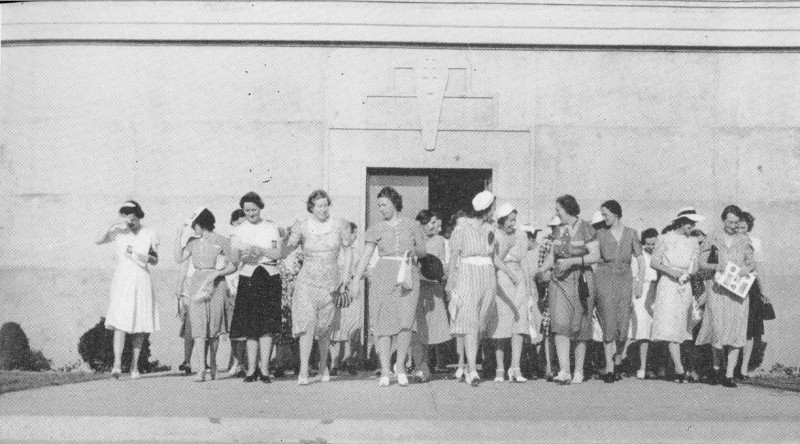
SPECIAL VISITS BY SCHOOL CLASSES AND OTHER CIVIC GROUPS MAY BE ARRANGED.
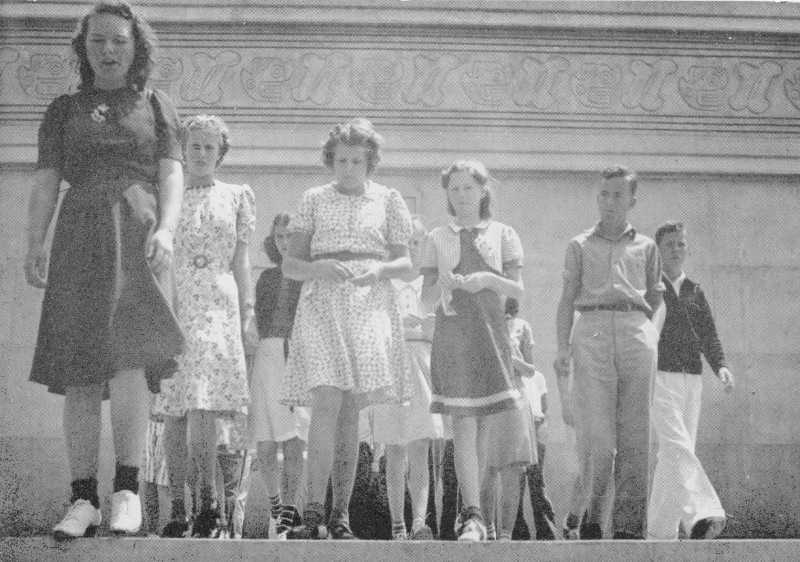

MOUNDS ARE DESIGNATED BY LETTERS.
Mound State Monument exists as an instrument for PRESERVATION. Visitors are requested to aid the Monument administration by carefully observing the following regulations. These rules are enforced for the comfort and convenience of the visitor as well as for the protection of scenic and archaeologic features.
Monument roadways are altogether recreational in character and the speed of vehicle traffic is therefore limited to 15 miles per hour. Drive carefully for the protection of yourself and other visitors.
The Monument is a wildlife sanctuary. Birds and animals must not be molested. HUNTING AND FISHING ARE PROHIBITED. Firearms or air rifles must not be carried within the Monument boundaries.
Trees and shrubs must not be broken. Do not carve initials on or pull the bark from trees. Flowers must not be picked. The injury or defacement of any natural feature is prohibited.
To solicit or sell anything, no matter of what nature, except by persons holding contract with Mound State Monument is prohibited.
No advertising, or distribution of placards or advertising matter, is permitted on the Monument grounds.
Fires are one of the greatest perils to the natural features of the Monument. Smokers are requested to exercise care in the disposal of matches, cigarettes etc. Picknickers must confine fires to designated areas and extinguish them completely before leaving.
All visitors are welcome to utilize the public picnic area and campground. Picnicking must be confined to sites designated by the caretaker.
Do not throw paper, lunch refuse or other trash on the roads, trails, or elsewhere. Deposit all such debris in the receptacles provided for that purpose. Picnickers may burn combustible rubbish in incinerators.
Special permission must be obtained to use picnic areas after dark.
To mar or deface any building, or to mark, disturb or injure any archaeologic feature on the Monument grounds, is a violation of the law.
The caretaker and guides are here to help and advise you as well as to enforce regulations. Consult them about anything pertaining to the Monument.


ERSKINE RAMSAY ARCHAEOLOGICAL RESEARCH LABORATORY.
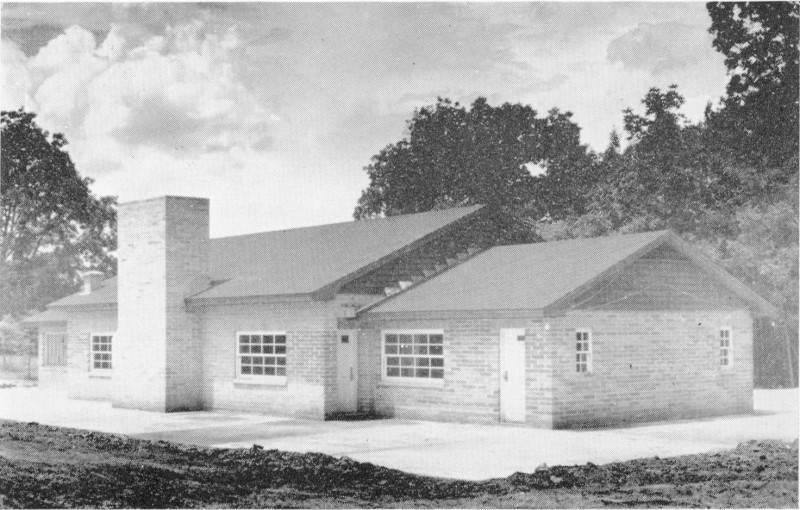
PICNIC BUILDING, MEMORIAL TO NELSON JONES.
As mentioned earlier, the laboratory unit and one cottage of the Research Center have been completed. Archaeological material, including skeletons from the Museum’s extensive excavations in the Tennessee Valley Region in Alabama, its earlier work in Eastern Arkansas, surface collections from all over Alabama and from scattered excavations in many parts of the state, has been assembled in especially designed storage racks in the main part of the building. Our plan is to have all of the Museum’s archaeological material, photographs, field notes, and library at this central point, where any part of it may be studied and comparisons made with other parts. Archaeologists are invited to avail themselves of the opportunity thus afforded.
Artifacts of clay, bone, shell, copper, flint, and stone are packed in pasteboard cartons which are numbered according to site and type of material. Skeletal material is packed in butter tubs and pasteboard cartons. All bones have been carefully cleaned, soaked in permanent hardener, and catalogued. All records of excavations, surveys, profiles, field notes, topographic sheets, index catalogues, et cetera are also housed in the building.
We are proud to have such a fine lot of material available in one building.
This building, on a high bluff overlooking the Warrior River, was covered in the original master plan for the area. It was made possible through a large donation by two friends of the Museum who wish that their identity be withheld.
The central section of the building is equipped with banquet type tables and folding chairs, having a seating capacity of about 200. In the west wing is a fully equipped kitchen and large barbecue pit. In the east wing are rest rooms, with outside entrances.
Around the building is a large concrete terrace which is equipped with portable tables and built-on seats, each with a capacity of eight people. The terrace will accommodate about 300 people.
Through special arrangement with the Director, the Curator, or the Park Manager, the building may be reserved for picnic groups having their own lunches, or for parties wishing to use kitchen facilities.
Charges for school groups with their own lunches: 10c each; for other parties having their own food: $5.00 minimum, or 10c each, whichever amount is the larger; with somewhat more being charged for use of kitchen facilities, depending upon type of food preparation required.
Coca-Cola dispensing machine is available in the building.

End of the Project Gutenberg EBook of Mound State Monument, Moundville,
Alabama, by Alabama Museum of Natural History
*** END OF THIS PROJECT GUTENBERG EBOOK MOUND STATE MONUMENT, MOUNDVILLE, ALABAMA ***
***** This file should be named 59208-h.htm or 59208-h.zip *****
This and all associated files of various formats will be found in:
http://www.gutenberg.org/5/9/2/0/59208/
Produced by Stephen Hutcheson and the Online Distributed
Proofreading Team at http://www.pgdp.net
Updated editions will replace the previous one--the old editions will
be renamed.
Creating the works from print editions not protected by U.S. copyright
law means that no one owns a United States copyright in these works,
so the Foundation (and you!) can copy and distribute it in the United
States without permission and without paying copyright
royalties. Special rules, set forth in the General Terms of Use part
of this license, apply to copying and distributing Project
Gutenberg-tm electronic works to protect the PROJECT GUTENBERG-tm
concept and trademark. Project Gutenberg is a registered trademark,
and may not be used if you charge for the eBooks, unless you receive
specific permission. If you do not charge anything for copies of this
eBook, complying with the rules is very easy. You may use this eBook
for nearly any purpose such as creation of derivative works, reports,
performances and research. They may be modified and printed and given
away--you may do practically ANYTHING in the United States with eBooks
not protected by U.S. copyright law. Redistribution is subject to the
trademark license, especially commercial redistribution.
START: FULL LICENSE
THE FULL PROJECT GUTENBERG LICENSE
PLEASE READ THIS BEFORE YOU DISTRIBUTE OR USE THIS WORK
To protect the Project Gutenberg-tm mission of promoting the free
distribution of electronic works, by using or distributing this work
(or any other work associated in any way with the phrase "Project
Gutenberg"), you agree to comply with all the terms of the Full
Project Gutenberg-tm License available with this file or online at
www.gutenberg.org/license.
Section 1. General Terms of Use and Redistributing Project
Gutenberg-tm electronic works
1.A. By reading or using any part of this Project Gutenberg-tm
electronic work, you indicate that you have read, understand, agree to
and accept all the terms of this license and intellectual property
(trademark/copyright) agreement. If you do not agree to abide by all
the terms of this agreement, you must cease using and return or
destroy all copies of Project Gutenberg-tm electronic works in your
possession. If you paid a fee for obtaining a copy of or access to a
Project Gutenberg-tm electronic work and you do not agree to be bound
by the terms of this agreement, you may obtain a refund from the
person or entity to whom you paid the fee as set forth in paragraph
1.E.8.
1.B. "Project Gutenberg" is a registered trademark. It may only be
used on or associated in any way with an electronic work by people who
agree to be bound by the terms of this agreement. There are a few
things that you can do with most Project Gutenberg-tm electronic works
even without complying with the full terms of this agreement. See
paragraph 1.C below. There are a lot of things you can do with Project
Gutenberg-tm electronic works if you follow the terms of this
agreement and help preserve free future access to Project Gutenberg-tm
electronic works. See paragraph 1.E below.
1.C. The Project Gutenberg Literary Archive Foundation ("the
Foundation" or PGLAF), owns a compilation copyright in the collection
of Project Gutenberg-tm electronic works. Nearly all the individual
works in the collection are in the public domain in the United
States. If an individual work is unprotected by copyright law in the
United States and you are located in the United States, we do not
claim a right to prevent you from copying, distributing, performing,
displaying or creating derivative works based on the work as long as
all references to Project Gutenberg are removed. Of course, we hope
that you will support the Project Gutenberg-tm mission of promoting
free access to electronic works by freely sharing Project Gutenberg-tm
works in compliance with the terms of this agreement for keeping the
Project Gutenberg-tm name associated with the work. You can easily
comply with the terms of this agreement by keeping this work in the
same format with its attached full Project Gutenberg-tm License when
you share it without charge with others.
1.D. The copyright laws of the place where you are located also govern
what you can do with this work. Copyright laws in most countries are
in a constant state of change. If you are outside the United States,
check the laws of your country in addition to the terms of this
agreement before downloading, copying, displaying, performing,
distributing or creating derivative works based on this work or any
other Project Gutenberg-tm work. The Foundation makes no
representations concerning the copyright status of any work in any
country outside the United States.
1.E. Unless you have removed all references to Project Gutenberg:
1.E.1. The following sentence, with active links to, or other
immediate access to, the full Project Gutenberg-tm License must appear
prominently whenever any copy of a Project Gutenberg-tm work (any work
on which the phrase "Project Gutenberg" appears, or with which the
phrase "Project Gutenberg" is associated) is accessed, displayed,
performed, viewed, copied or distributed:
This eBook is for the use of anyone anywhere in the United States and
most other parts of the world at no cost and with almost no
restrictions whatsoever. You may copy it, give it away or re-use it
under the terms of the Project Gutenberg License included with this
eBook or online at www.gutenberg.org. If you are not located in the
United States, you'll have to check the laws of the country where you
are located before using this ebook.
1.E.2. If an individual Project Gutenberg-tm electronic work is
derived from texts not protected by U.S. copyright law (does not
contain a notice indicating that it is posted with permission of the
copyright holder), the work can be copied and distributed to anyone in
the United States without paying any fees or charges. If you are
redistributing or providing access to a work with the phrase "Project
Gutenberg" associated with or appearing on the work, you must comply
either with the requirements of paragraphs 1.E.1 through 1.E.7 or
obtain permission for the use of the work and the Project Gutenberg-tm
trademark as set forth in paragraphs 1.E.8 or 1.E.9.
1.E.3. If an individual Project Gutenberg-tm electronic work is posted
with the permission of the copyright holder, your use and distribution
must comply with both paragraphs 1.E.1 through 1.E.7 and any
additional terms imposed by the copyright holder. Additional terms
will be linked to the Project Gutenberg-tm License for all works
posted with the permission of the copyright holder found at the
beginning of this work.
1.E.4. Do not unlink or detach or remove the full Project Gutenberg-tm
License terms from this work, or any files containing a part of this
work or any other work associated with Project Gutenberg-tm.
1.E.5. Do not copy, display, perform, distribute or redistribute this
electronic work, or any part of this electronic work, without
prominently displaying the sentence set forth in paragraph 1.E.1 with
active links or immediate access to the full terms of the Project
Gutenberg-tm License.
1.E.6. You may convert to and distribute this work in any binary,
compressed, marked up, nonproprietary or proprietary form, including
any word processing or hypertext form. However, if you provide access
to or distribute copies of a Project Gutenberg-tm work in a format
other than "Plain Vanilla ASCII" or other format used in the official
version posted on the official Project Gutenberg-tm web site
(www.gutenberg.org), you must, at no additional cost, fee or expense
to the user, provide a copy, a means of exporting a copy, or a means
of obtaining a copy upon request, of the work in its original "Plain
Vanilla ASCII" or other form. Any alternate format must include the
full Project Gutenberg-tm License as specified in paragraph 1.E.1.
1.E.7. Do not charge a fee for access to, viewing, displaying,
performing, copying or distributing any Project Gutenberg-tm works
unless you comply with paragraph 1.E.8 or 1.E.9.
1.E.8. You may charge a reasonable fee for copies of or providing
access to or distributing Project Gutenberg-tm electronic works
provided that
* You pay a royalty fee of 20% of the gross profits you derive from
the use of Project Gutenberg-tm works calculated using the method
you already use to calculate your applicable taxes. The fee is owed
to the owner of the Project Gutenberg-tm trademark, but he has
agreed to donate royalties under this paragraph to the Project
Gutenberg Literary Archive Foundation. Royalty payments must be paid
within 60 days following each date on which you prepare (or are
legally required to prepare) your periodic tax returns. Royalty
payments should be clearly marked as such and sent to the Project
Gutenberg Literary Archive Foundation at the address specified in
Section 4, "Information about donations to the Project Gutenberg
Literary Archive Foundation."
* You provide a full refund of any money paid by a user who notifies
you in writing (or by e-mail) within 30 days of receipt that s/he
does not agree to the terms of the full Project Gutenberg-tm
License. You must require such a user to return or destroy all
copies of the works possessed in a physical medium and discontinue
all use of and all access to other copies of Project Gutenberg-tm
works.
* You provide, in accordance with paragraph 1.F.3, a full refund of
any money paid for a work or a replacement copy, if a defect in the
electronic work is discovered and reported to you within 90 days of
receipt of the work.
* You comply with all other terms of this agreement for free
distribution of Project Gutenberg-tm works.
1.E.9. If you wish to charge a fee or distribute a Project
Gutenberg-tm electronic work or group of works on different terms than
are set forth in this agreement, you must obtain permission in writing
from both the Project Gutenberg Literary Archive Foundation and The
Project Gutenberg Trademark LLC, the owner of the Project Gutenberg-tm
trademark. Contact the Foundation as set forth in Section 3 below.
1.F.
1.F.1. Project Gutenberg volunteers and employees expend considerable
effort to identify, do copyright research on, transcribe and proofread
works not protected by U.S. copyright law in creating the Project
Gutenberg-tm collection. Despite these efforts, Project Gutenberg-tm
electronic works, and the medium on which they may be stored, may
contain "Defects," such as, but not limited to, incomplete, inaccurate
or corrupt data, transcription errors, a copyright or other
intellectual property infringement, a defective or damaged disk or
other medium, a computer virus, or computer codes that damage or
cannot be read by your equipment.
1.F.2. LIMITED WARRANTY, DISCLAIMER OF DAMAGES - Except for the "Right
of Replacement or Refund" described in paragraph 1.F.3, the Project
Gutenberg Literary Archive Foundation, the owner of the Project
Gutenberg-tm trademark, and any other party distributing a Project
Gutenberg-tm electronic work under this agreement, disclaim all
liability to you for damages, costs and expenses, including legal
fees. YOU AGREE THAT YOU HAVE NO REMEDIES FOR NEGLIGENCE, STRICT
LIABILITY, BREACH OF WARRANTY OR BREACH OF CONTRACT EXCEPT THOSE
PROVIDED IN PARAGRAPH 1.F.3. YOU AGREE THAT THE FOUNDATION, THE
TRADEMARK OWNER, AND ANY DISTRIBUTOR UNDER THIS AGREEMENT WILL NOT BE
LIABLE TO YOU FOR ACTUAL, DIRECT, INDIRECT, CONSEQUENTIAL, PUNITIVE OR
INCIDENTAL DAMAGES EVEN IF YOU GIVE NOTICE OF THE POSSIBILITY OF SUCH
DAMAGE.
1.F.3. LIMITED RIGHT OF REPLACEMENT OR REFUND - If you discover a
defect in this electronic work within 90 days of receiving it, you can
receive a refund of the money (if any) you paid for it by sending a
written explanation to the person you received the work from. If you
received the work on a physical medium, you must return the medium
with your written explanation. The person or entity that provided you
with the defective work may elect to provide a replacement copy in
lieu of a refund. If you received the work electronically, the person
or entity providing it to you may choose to give you a second
opportunity to receive the work electronically in lieu of a refund. If
the second copy is also defective, you may demand a refund in writing
without further opportunities to fix the problem.
1.F.4. Except for the limited right of replacement or refund set forth
in paragraph 1.F.3, this work is provided to you 'AS-IS', WITH NO
OTHER WARRANTIES OF ANY KIND, EXPRESS OR IMPLIED, INCLUDING BUT NOT
LIMITED TO WARRANTIES OF MERCHANTABILITY OR FITNESS FOR ANY PURPOSE.
1.F.5. Some states do not allow disclaimers of certain implied
warranties or the exclusion or limitation of certain types of
damages. If any disclaimer or limitation set forth in this agreement
violates the law of the state applicable to this agreement, the
agreement shall be interpreted to make the maximum disclaimer or
limitation permitted by the applicable state law. The invalidity or
unenforceability of any provision of this agreement shall not void the
remaining provisions.
1.F.6. INDEMNITY - You agree to indemnify and hold the Foundation, the
trademark owner, any agent or employee of the Foundation, anyone
providing copies of Project Gutenberg-tm electronic works in
accordance with this agreement, and any volunteers associated with the
production, promotion and distribution of Project Gutenberg-tm
electronic works, harmless from all liability, costs and expenses,
including legal fees, that arise directly or indirectly from any of
the following which you do or cause to occur: (a) distribution of this
or any Project Gutenberg-tm work, (b) alteration, modification, or
additions or deletions to any Project Gutenberg-tm work, and (c) any
Defect you cause.
Section 2. Information about the Mission of Project Gutenberg-tm
Project Gutenberg-tm is synonymous with the free distribution of
electronic works in formats readable by the widest variety of
computers including obsolete, old, middle-aged and new computers. It
exists because of the efforts of hundreds of volunteers and donations
from people in all walks of life.
Volunteers and financial support to provide volunteers with the
assistance they need are critical to reaching Project Gutenberg-tm's
goals and ensuring that the Project Gutenberg-tm collection will
remain freely available for generations to come. In 2001, the Project
Gutenberg Literary Archive Foundation was created to provide a secure
and permanent future for Project Gutenberg-tm and future
generations. To learn more about the Project Gutenberg Literary
Archive Foundation and how your efforts and donations can help, see
Sections 3 and 4 and the Foundation information page at
www.gutenberg.org
Section 3. Information about the Project Gutenberg Literary Archive Foundation
The Project Gutenberg Literary Archive Foundation is a non profit
501(c)(3) educational corporation organized under the laws of the
state of Mississippi and granted tax exempt status by the Internal
Revenue Service. The Foundation's EIN or federal tax identification
number is 64-6221541. Contributions to the Project Gutenberg Literary
Archive Foundation are tax deductible to the full extent permitted by
U.S. federal laws and your state's laws.
The Foundation's principal office is in Fairbanks, Alaska, with the
mailing address: PO Box 750175, Fairbanks, AK 99775, but its
volunteers and employees are scattered throughout numerous
locations. Its business office is located at 809 North 1500 West, Salt
Lake City, UT 84116, (801) 596-1887. Email contact links and up to
date contact information can be found at the Foundation's web site and
official page at www.gutenberg.org/contact
For additional contact information:
Dr. Gregory B. Newby
Chief Executive and Director
gbnewby@pglaf.org
Section 4. Information about Donations to the Project Gutenberg
Literary Archive Foundation
Project Gutenberg-tm depends upon and cannot survive without wide
spread public support and donations to carry out its mission of
increasing the number of public domain and licensed works that can be
freely distributed in machine readable form accessible by the widest
array of equipment including outdated equipment. Many small donations
($1 to $5,000) are particularly important to maintaining tax exempt
status with the IRS.
The Foundation is committed to complying with the laws regulating
charities and charitable donations in all 50 states of the United
States. Compliance requirements are not uniform and it takes a
considerable effort, much paperwork and many fees to meet and keep up
with these requirements. We do not solicit donations in locations
where we have not received written confirmation of compliance. To SEND
DONATIONS or determine the status of compliance for any particular
state visit www.gutenberg.org/donate
While we cannot and do not solicit contributions from states where we
have not met the solicitation requirements, we know of no prohibition
against accepting unsolicited donations from donors in such states who
approach us with offers to donate.
International donations are gratefully accepted, but we cannot make
any statements concerning tax treatment of donations received from
outside the United States. U.S. laws alone swamp our small staff.
Please check the Project Gutenberg Web pages for current donation
methods and addresses. Donations are accepted in a number of other
ways including checks, online payments and credit card donations. To
donate, please visit: www.gutenberg.org/donate
Section 5. General Information About Project Gutenberg-tm electronic works.
Professor Michael S. Hart was the originator of the Project
Gutenberg-tm concept of a library of electronic works that could be
freely shared with anyone. For forty years, he produced and
distributed Project Gutenberg-tm eBooks with only a loose network of
volunteer support.
Project Gutenberg-tm eBooks are often created from several printed
editions, all of which are confirmed as not protected by copyright in
the U.S. unless a copyright notice is included. Thus, we do not
necessarily keep eBooks in compliance with any particular paper
edition.
Most people start at our Web site which has the main PG search
facility: www.gutenberg.org
This Web site includes information about Project Gutenberg-tm,
including how to make donations to the Project Gutenberg Literary
Archive Foundation, how to help produce our new eBooks, and how to
subscribe to our email newsletter to hear about new eBooks.